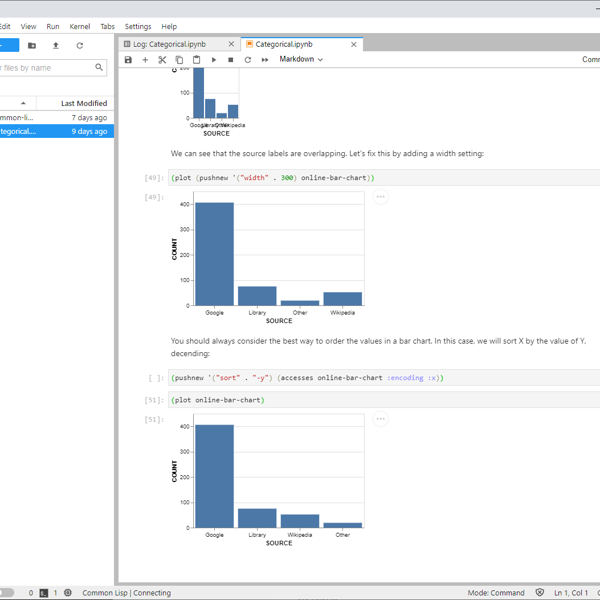Statistical Analysis with Lisp-Stat
Lisp-Stat is the culmination of many months work to pull together the best-in-class statistical analysis packages available in Common Lisp, under a commercially friendly license, usable ‘out of the box’. It is an environment for statistical computing, conceptually similar to R, that is also suitable for front-line production deployments. It grew out of a desire to have an environment for rapidly prototyping analytical and A.I. solutions, and move directly to production environments with minimal friction. Typically there is a gap between the modeling environment, perhaps R or Python, and the delivery environment. Lisp-Stat closes that gap.
Lisp-Stat is in daily use for statistical analysis and is now considered ready for a broader audience.
Why Lisp?
We had a few requirements when evaluating options. Specifically the system had to:
- Work well in the kind of exploratory environment conducive to analytics and AI
- Be robust enough to be deployed in an enterprise-level production environment
- Be available under a license without source code restrictions
Common Lisp was the only framework that met all these requirements. And, it is not the first time lisp has been used in a statistical setting. XLISP-STAT, our spiritual predecessor, was a contemporary of R in the early days of development. Wikipedia says about it: “XLispStat was historically influential in the field of statistical visualization” and its author, Luke Tierney, was a member of the original R core team.
What does Lisp-Stat do?
Lisp-Stat provides support for vectorized mathematical operations, a super-set of common lisp array operations, and a comprehensive set of statistical methods that are implemented using the latest numerical algorithms. In addition, Common Lisp provides a dynamic programming environment that includes a REPL for interactive evaluation of code, CLOS, an excellent object oriented environment and a meta-object protocol (MOP).
We have also compiled an archive of XLISP-STAT libraries that can be ported with the aid of a compatibility package (XLS). This gives Lisp-Stat a leg up on ecosystem development; there are many useful statistical routines in the archive.
Getting Started
If you are familiar with R, and want to understand how to do similar things with Lisp-Stat, the basic tutorial is the place to begin. If you have a Common Lisp installation and want give Lisp-Stat a quick try, start with Install to Plot in 5 minutes. For newcomers to lisp, see the Installation section for how to get going from ground zero.
What’s in the box?
All the basics for descriptive statistical analysis.
Data Frames
Load the classic R mtcars data set into a data frame:
(data :mtcars)
Plotting
The plotting examples show how to plot the horsepower vs. miles-per-gallon of the similar Vega-Lite data set:
(plot:plot
(vega:defplot hp-mpg
`(:title "Horsepower vs. MPG"
:data (:values ,vgcars)
:mark :point
:encoding (:x (:field :horsepower :type :quantitative)
:y (:field :miles-per-gallon :type :quantitative)))))
Jupyter notebooks
For reproducible research and sharing.

Lisp-Stat running in a Jupyter-Lab notebook
Examples & Tutorials
The examples show how to create commonly used statistical plots and the analytic examples work through the examples of the book Introduction to the Practice of Statistics using Lisp-Stat.
Example data sets
About 1500 R data sets can be
loaded using the rdata package.
Where do I get help?
The community page page describes how the project is structured. Help can be obtained from:
Where did it come from?
Several of these libraries are based on the work of Tamas K
Papp, who was working as a practicing
econometrician using Common Lisp before leaving the community for
Julia. One of the design goals for Lisp-Stat was to avoid the Lisp
Curse that
plagues so many common lisp niches, including statistics. So, rather
than reinvent the wheel, we took some existing wheels, greased and
polished them, added documentation and filed off the rough edges to
make them work smoothly together in an integrated environment. The
greenfield work includes special functions and plot.
Haven’t I seen this before?
You may have. In late March 2021 existence of Lisp-Stat was leaked to Hacker News and Reddit. At that time, we were still getting Lisp-Stat ready for general release, and things were not quite where we wanted them to be. If you saw the original leaked version, here are the changes:
- Documentation:
- Reorganized getting started, tutorials, reference
- Added plotting and data-frame examples
- Added “Install to plot in 5 minutes” getting started guide
- Expanded analytic examples
- Expanded basic tutorial
- QA: spelling, grammar, typos, examples
- Added resources section
- Added search
- Data Frame
- Added pretty printing
- Added markdown printing
- Added variable shortcuts, you can now refer to a variable by name in all contexts
- Added head, tail, summary, column-name functions
- Added define-data-frame macro
- Miscellaneous bug fixes
- Plot
- Added box plot
- Added histogram